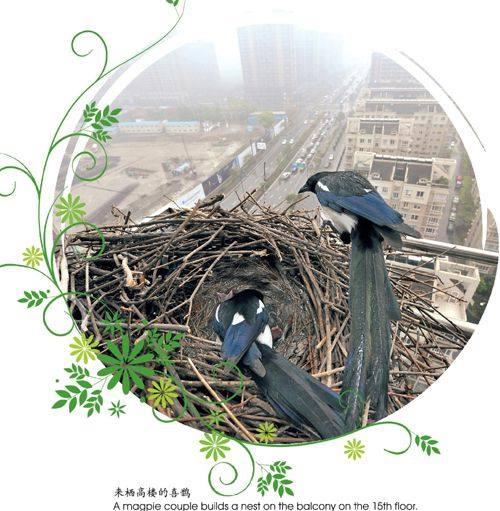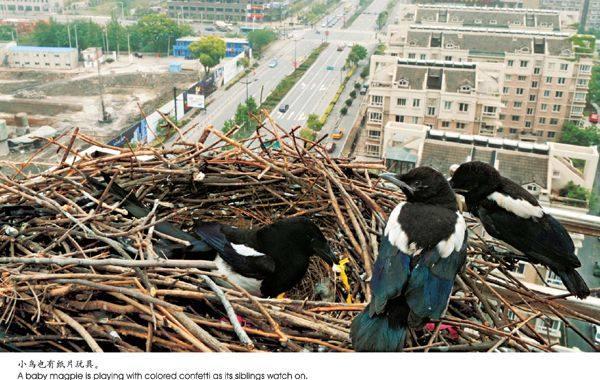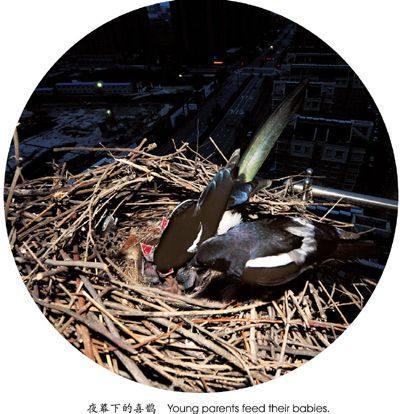拍案叫绝“喜临门”
2012-04-29傅通先
傅通先



“哇!太精彩了!”“不敢说绝后,但绝对是空前的!”10月30日,参加“千年运河,拱墅记忆”采风活动的作家们,拿到许明赠予的《窗前喜鹊》摄影集之后,莫不眼前一亮,倾心赞叹。他坚守71天拍摄的一双喜鹊从筑巢、孵化、育雏到出窝的329幅精彩照片,破天荒记录了七只喜鹊生活、生育、生长的全过程,发现了许多人类尚未知晓的喜鹊习性,堪称摄影史上的一大突破。
作为醉心喜鹊题材的习画者,我更是大喜过望,并于3天后专门造访了这位摄影家。
千姿百态的喜鹊群像
2010年3月2日,家住大运河拱宸桥畔一幢高楼15层楼的许明家阳台花架上,飞来两只喜鹊衔枝筑巢。曾出版过摄影作品集《羌塘豪情——一位援藏县委书记的视野》的许明敏锐地意识到:一个千载难逢的摄影题材名副其实地“喜”从天降了。
喜鹊寓意吉祥、喜庆、幸运、福音,为中华文化喜闻乐见的表达元素,但这种灵性之鸟往往营巢于高枝、铁塔上,飞入寻常人家的阳台安家极为罕见,如今岂可错过这拍摄的天赐良机!许明当即决定:把整个阳台和连接阳台的书房全部让给两位“嘉宾”。同时,移开花架前的玻璃窗,架起相机和录像机,记录喜鹊安家生育的全过程。
鹊巢从一两日的稀稀拉拉,五六日的花花搭搭,到十几日的密密匝匝,历时整整20天,一个如同北京奥运会“鸟巢”模样的内外三层鹊巢终于筑成。自动照相机咔嚓咔嚓地拍摄,喜鹊丰富的肢体语言和欢快、不安、爱恋、愤怒的表情一一定格在显示屏上。而为了追求最佳的摄影效果,许明常常利用工作余暇,手动撷取精彩画面。
3月21日,巢内出现了第一枚蛋,隔一日,又产下第二枚,然后每日一蛋,六天共下五蛋。有黑褐色斑点的浅蓝绿色蛋,约长3.8厘米,宽2.6厘米。孵蛋任务由雌鹊担当,雄鹊负责守护和觅食。雌鹊会不时用喙翻动蛋,让孕育的小生命也能运动一下。就这样,巢下的道路车水龙马,巢内的喜鹊忙忙碌碌,映衬出一幅事业发达、生活安详的生动画面。
4月11日,两只小喜鹊破壳而出,皮肤鲜红娇嫩,脑袋硕大,双眼未开,时而仰天张开血红的嘴巴,似乎在宣告新生命的降临。翌日,又有两个小生命来到世上。第三日,随着最后一只雏鸟破壳,一个七口之家完满组成。恰在这时,“倒春寒”来临,气温骤降,雌喜鹊一动不动地扎着“马步”,用自身的体温细心地呵护着小宝贝,表现出感人的母爱。雄喜鹊对一家关怀备至,在日夜守护的同时,勤勉觅食,为一家及时送上可口的饭菜。
4月29日,羽翼渐丰的小鸟第一次出巢学飞:展翅、扇翮、俯首、翘尾,父母在一旁关切地看护着。
第71天,当最后一只雏鸟出窝飞走时,许明的相机里已经留下了2万多张照片,这是人类第一次对野生喜鹊生育过程的翔实记录。形形色色的喜鹊表情,千姿百态的喜鹊动作,强烈冲击着人们的视觉神经,让人叹为观止。
喜鹊摄影的重大突破
拍鸟,摄影迷们无一例外地使用“长枪大炮”。而为了求得景深效果,许明首次采用广角镜头拍鸟。不仅如此,他还第一次记录了喜鹊将蛋壳撕碎吃掉,第一次记录了喜鹊从幼鸟嘴中取出食物残渣的情景,第一次记录了雏鸟跟人类的孩子一样喜爱玩具。
4月11日,许明惊奇发现,当小喜鹊破壳出世之后,雌喜鹊会把整个蛋壳吃掉。对不能下咽的大块蛋壳,它会足踩蛋壳,用喙撕碎,然后吃掉。既清洁鸟巢,又补充钙质。这些都被许明清晰地记录下来。
4月25日,许明又有了新发现:雌喜鹊从小鸟嘴里叼出一块黄褐色的大残渣。原来,小喜鹊消化功能尚未健全,不能自主吐出食物残渣。细心的父母便及时而利索地帮助崽崽解决难题。
5月8日,楼下有人喜结连理,发射了好些庆贺的纸花弹。散落在草坪上的一些彩纸片被大喜鹊衔到了50米高的巢里,供小鸟叼弄玩耍。原来,小喜鹊也有这般“童趣”。
浙江自然博物馆鸟类专家陈水华看了这些实录,欣喜地说:老许的这些珍贵记录,让我们这些专业人士也开了眼界,了解到好些喜鹊研究的未知领域。
魂牵梦萦的人鸟情缘
五只小喜鹊安然出窝,离开了这个安全而温馨的家。许明庆幸“喜”临家门,让他拍到了前人未能企及的2万多幅照片,也时时牵挂这一家子生活可好?何处安身?魂牵梦萦中,发现它们中会有一两只短暂返巢,许明就像见到久别重逢的亲人那样兴高采烈,欢快地注视它们的一举一动。
为了让更多人分享成果,许明选取了5幅照片参加全国摄影艺术展览。评委评价:“他的作品看似随意和不经心,但其中蕴藏着生动和朴实以及令人回味的寓意。城市、环境、动物与人,其实就在你身边,故事每天都在发生。”
2011年11月,许明从2万余幅照片中精选出329幅,按时间顺序编辑成册,交由中国摄影出版社出版,获得广泛好评。中国美术出版社闻讯之后,专门向许明约稿,期望他能从艺术的角度重编一本艺术作品,让生态文明之风吹拂更远。
从喜鹊前来安家的事件中,许明切身体会到建设良好生态环境的重要性。他任职的“十里银湖墅”,地处千里京杭大运河的起始端,川泽沃衍,珍异广聚,商贾云集,舳舻相接。他决意与拱墅人民一起,在建设“美丽中国”的进程中,让这片繁华富饶之地,生态文明建设更上一层楼,为百姓打造更优美的环境,为鸟类营造更多的栖息乐园,让那时时牵挂的七口之家共享一片青山、绿水和蓝天。
(本文摄影:许明)
Magpies: Over 20,000 Photos in 71 Days
By Fu Tongxian
On October 30, 2012, we amateur photographers met to do field work in Gongshu, a district in the north of downtown Hangzhou. To our surprise and delight, we each received a copy of a photograph album created by Xu Ming, the former CPC secretary of Gongshu District. Entitled “Magpies in Front of My Window”, the album presents 329 photos, out of over 20,000 taken in 71 days in 2010, of a couple of adult magpies building a nest, laying eggs, breeding five baby magpies, baby magpies growing up, the family moving away.
Interested in painting magpies myself, I was overjoyed by the amazing photographs. Three days later, I visited the photographer to find out how he had spent 71 days photographing the magpies nesting on the balcony of his apartment on the fifteenth floor of an apartment building on the Beijing-Hangzhou Grand Canal, which traverses the downtown Hangzhou.
On March 2, 2010, Xu Ming found two magpies come to the flower racket on the balcony. An experienced enthusiast of photography, he realized that the magpies were a godsend for him to photograph, as in the Chinese culture, magpies are birds of happiness, luck, pleasure. He considered the birds as happiness coming from heaven.
As magpies usually build their nests high in trees or on the top of power towers, Xu Ming found it quite unusual that the couple came to his balcony. The avian guests thrilled him. He decided to photograph the birds on the balcony. To minimize disturbance, he decided not to use the balcony and the study that leads to the balcony as long as the birds stayed there. The large pane of the window between the balcony and the study was removed so that his cameras would have a clearer look at the birds. He set up a camera and a camcorder to record the whole reproduction process. Set on the automatic mode and with a wide-angle lens, the camera took a photograph every minute during daytime. In addition, he used another camera to capture good moments when he had time to watch.
The photographs tell the story of the magpies building a nest. It took the birds 20 days to finish the building project. In the first few days, the nest looked sketchy; after five days, it looked fleshed out. After ten days, it looked entangled. After twenty days, the nest looked like the National Stadium in Beijing, nicknamed the Bird Nest and especially built for the 2008 Beijing Olympic Games.
On March 21, the first egg appeared in the nest. In the following five days, another four eggs appeared. The would-be mother sat and the would-be father watched and guarded the nest. The female moved the eggs now and then.
On April 11, the first two baby magpies came out. The next day saw another two babies hatched. On April 13, the last one came. The family of two became a family of seven.
On April 29, the chicks began to learn how to fly, with their parents watching anxiously. On the 71st day, the parents and babies all flew away. They did not come back.
The complete record of the 71 days and nights of the magpies contains a lot of surprises for scientists too. The photos show how the magpies tore the eggshells to pieces and ate them, how the adult magpies took the food remains out of the baby magpies beaks. On May 8, the adult magpies picked some paper confetti from the lawn fifty meters below the balcony and brought colorful shreds to the nest. The baby magpies were happy to play with them, treating the paper as toys.
Chen Shuihua, a bird expert with Zhejiang Natural Museum, was delighted to review the photographic record, which he says opened his eyes to some unknown behavior of magpies.
Xu Ming was thrilled to have the whole collection of the photographs. He selected five out of his precious collection and sent them to the National Photography Art Exhibition. The photos were highly appreciated at the national event.
In November 2011, Xu selected 329 photographs out of the over 20,000 pieces, chronically arranged to reflect the amazing life of the magpies over the 71 days and nights on the balcony. The album was published by China Photography Press. The album has received rave reviews. After learning about the collection, China Fine Art Press offered Xu Ming a contract to publish another collection. This time, the collection is supposed to give art a special angle.
